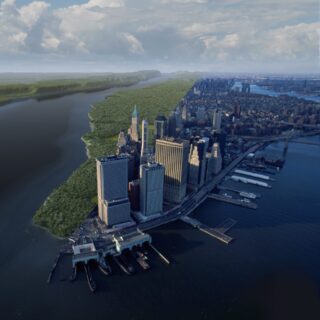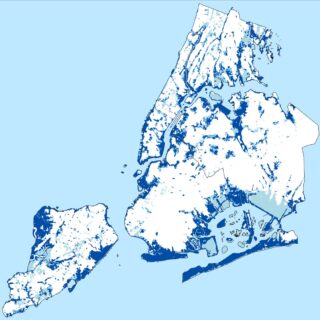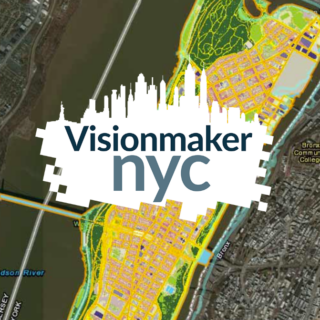
Urban Conservation
Cities across the globe are facing imminent biodiversity, climate, and environmental justice crises. In the heart of the United States’ largest metropolis, NYBG has a unique opportunity to act as a catalyst for innovation and solutions.
NYBG’s research in urban conservation emphasizes the importance of nature to cities and the importance of cities to nature. We believe that cities are an important part of the solution to our environmental crises, with enormous capacity to simultaneously improve human lives and minimize human impact on the environment. We leverage scientific and public platforms to propose solutions to pressing environmental challenges, creating our own digital tools for public use along the way. By partnering with local communities, government agencies, and other organizations, we develop and convey the understanding necessary to adapt cities to a changing climate. Through education and exhibitions, we express the complex and affirming ways that fostering nature improves cities and the planet, while collaborating to build and sustain communities that create and affirm ecologies in cities and elsewhere.
Our Projects
Historical ecology

Welikia
Have you ever wondered what your neighborhood looked like 400 years ago? Launching on April 22, the Urban Conservation team’s revamped Welikia Map Explorer allows you to explore the historical ecology of any block within the five boroughs of New York City. In just a click, you can view all the plants and animals that once thrived on your block, discover the original ecosystems underlying your street, and reconnect with the nature that was native to the city.
Ecological democracy
Visionmaker
Cities are planned and built with many purposes in mind, but rarely is nature one of those purposes. Visionmaker aims to change that. Visionmaker is a platform for creating and sharing visions of the future. It is free, open to the public, and runs scientific models of the carbon cycle, water cycle, biodiversity, energy consumption, geography, and population. Visionmaker is intended to facilitate ecological democracy, where everyone has access to the same set of tools and an equal opportunity to contribute to the conversation about better, more natural cities, especially as the climate changes.
Environmental governance
 Blue Zones
Blue Zones
NYC faces the imminent threat of increased flooding due to climate change: Hurricane Sandy in 2012 showed the city the frightening power of coastal storms, and Hurricane Ida in 2021 demonstrated the destructive power of intense rainfall events. To help NYC understand where the next extreme weather event will hit, NYBG is analyzing the patterns of historical flooding based on past distributions of streams, wetlands, and beaches, then comparing them to maps of present-day flooding. Through this analysis, we identify Blue Zones, or areas that once flooded, flood now, and are predicted to flood in the future. Blue Zones help provide a targeted gaze on high-resk areas for flood mitigation solutions.
Active restoration
Bronx River Watershed
The Bronx River is a beloved natural feature of the NYBG landscape, running for nearly a mile through the eastern side of the Garden. It is the heart of our 50-acre, old-growth Thain Family Forest. As a natural corridor connecting urban New York City with suburban southern Westchester, it is critical to communities across county lines for its biodiversity, natural beauty and recreational opportunities. Working together with local government, non-profit, and academic partners, NYBG is crafting a multi-faceted and phased program to annually convene public and private stakeholders to identify river priorities; develop outreach programs to engage communities within the watershed critical for river biodiversity and resilience; and develop and implement plant-based strategies to improve the health of the river. This program is led by NYBG’s Horticulture program in close collaboration with the Urban Conservation program.
Ecohydrology of NYC
Flood risk management is essential for cities. While, historically, flood risk management has been dominated by ‘gray’ infrastructure approaches, NYBG is adopting an ecohydrology-centered approach based on plants and healthy ecosystems that help cites adapt to a climate-altered future. The garden contains a landscape of many different urban ecosystems, providing a valuable opportunity to measure how water flows into and out of ecosystems, including interception, infiltration, evapotranspiration, storage, overland and groundwater flow, and flooding. By instrumenting our various ecosystems, we can utilize the landscape the garden as an “ecosystem laboratory” to collect data to inform the design and maintenance of green infrastructure; create a teaching platform for training environmentally-minded horticulturalists; and develop new understanding of the performance characteristics of urban ecosystems.
Contact
- General contact: urbanconservation@nybg.org
- People
-
- Dr. Eric Sanderson, PhD; Vice President for Urban Conservation
-
-
- Esanderson@nybg.org
- Ext #8783
-
-
- Genesis Abreu; Director of Urban Conservation Partnerships
-
-
- Gabreu@nybg.org
- Ext. #8973
-
-
- Annie Fu; Geospatial Developer and Systems Administrator
-
-
- Afu@nybg.org
- Ext. #8012
-
-
- Jesse Moy; Computer Visualization Artist
-
-
- Jmoy@nybg.org
- Ext. #8773
-
-
- Lucinda Royte; Manager of Urban Conservation Data, Tools, and Outreach
-
-
- Lroyte@nybg.org
- Ext. #8950
-
